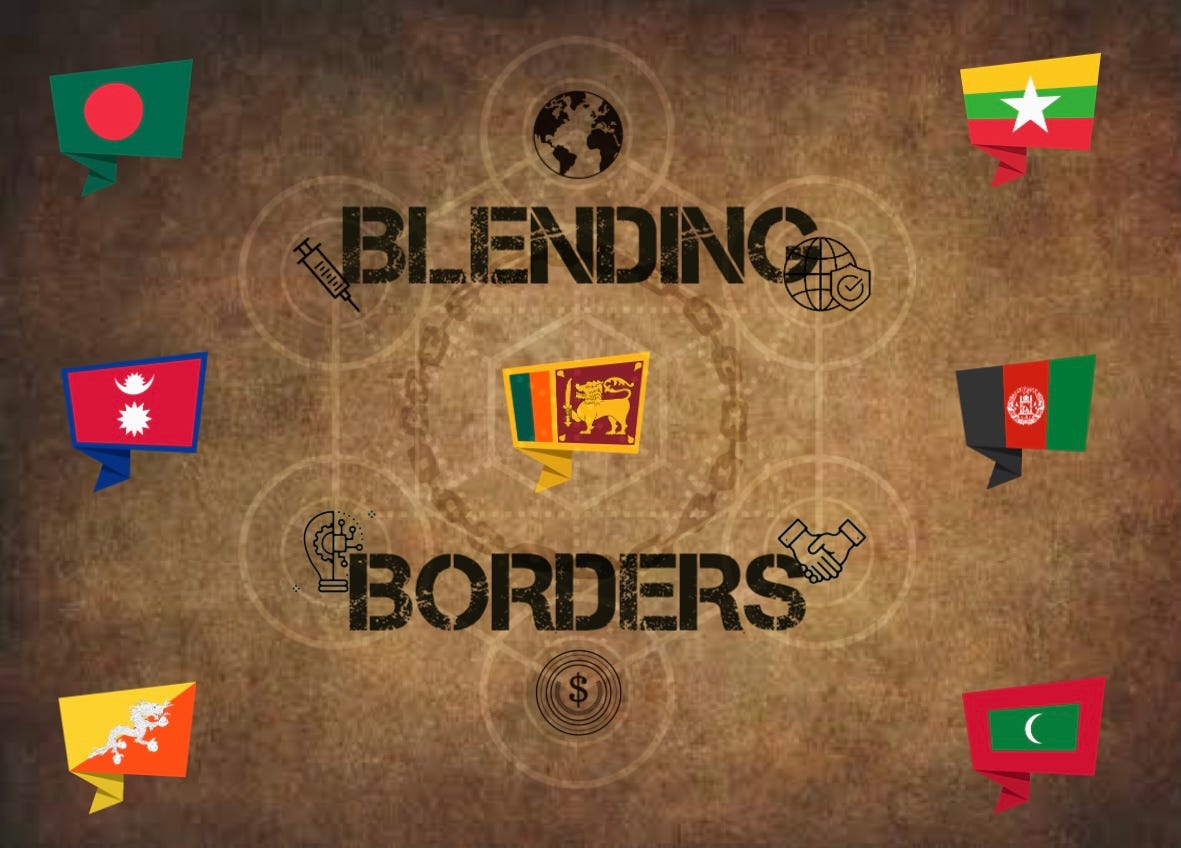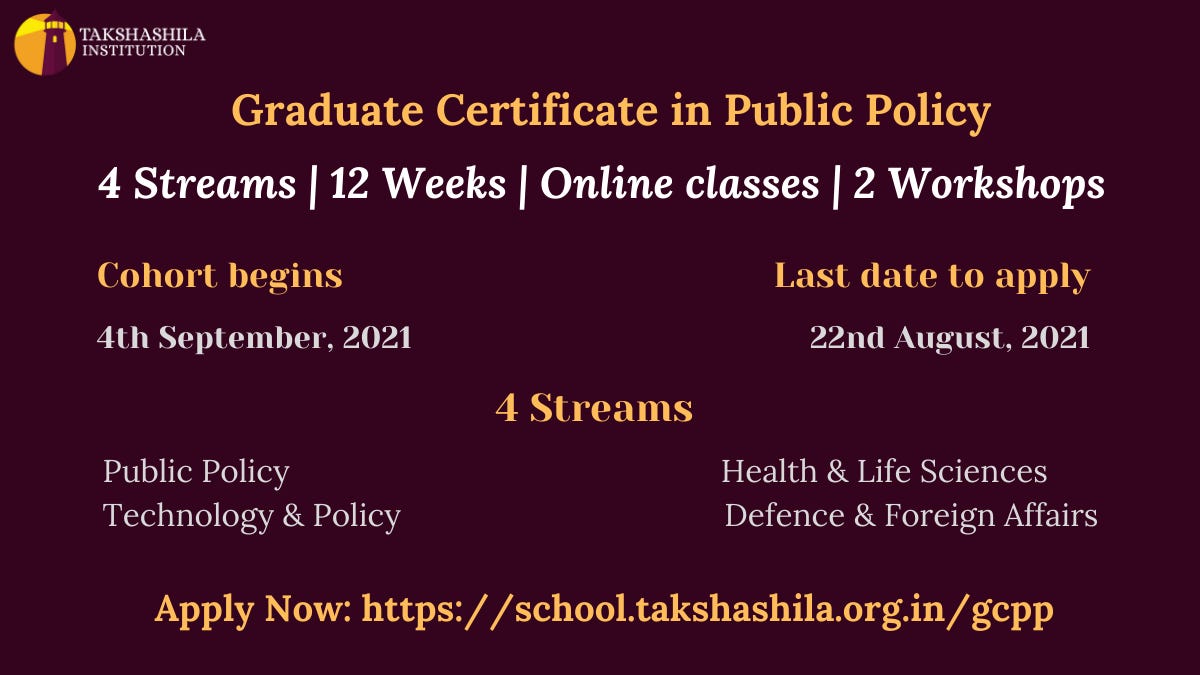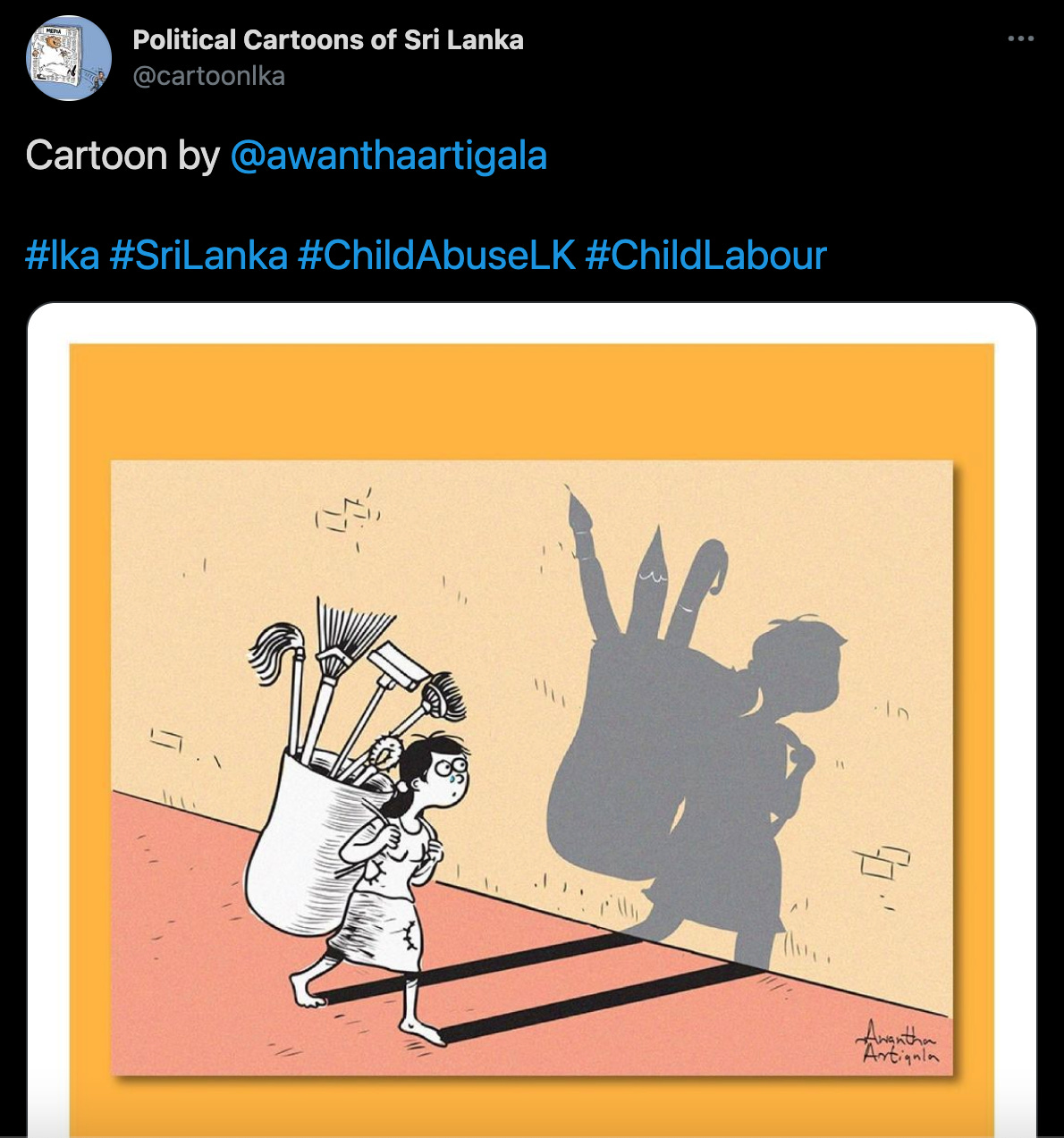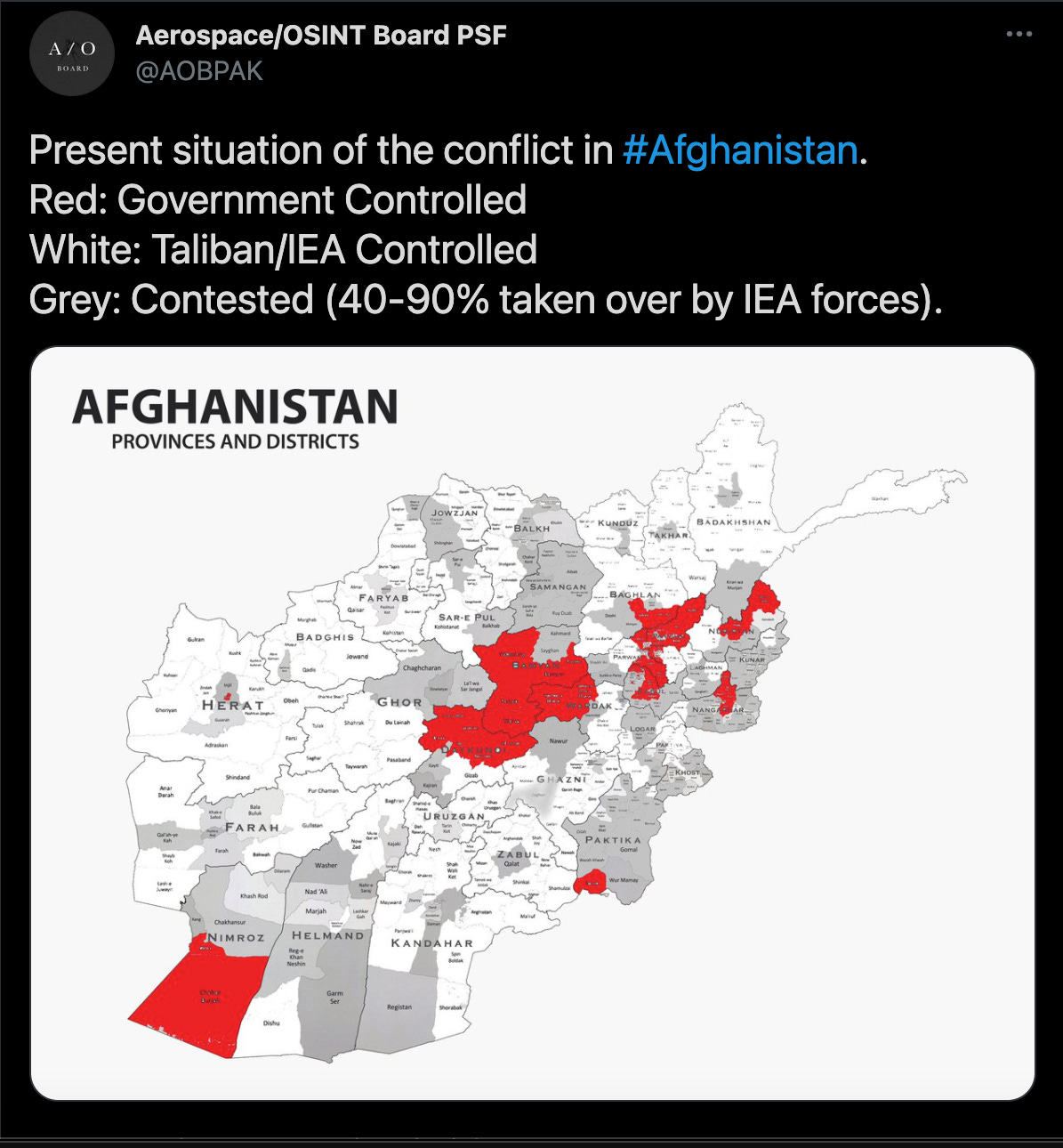Blending Borders #4
Blending Borders
A Fortnightly Newsletter
July 27th, 2021
Issue #4
This Newsletter explores ongoing issues and perspectives from India’s neighbouring countries, including - Sri Lanka, Bangladesh, Nepal, Myanmar, Bhutan, Maldives and Afghanistan.
Before I begin, The Takshashila Institution is offering a 12-week public policy course in any of the following streams of your choice - Public Policy, Health & Life Sciences, Technology & Policy and Defence & Foreign Affairs. It is all online and can be taken from anywhere. If you are interested in applying for any of the above courses, click here for details and more information on each specific course.
In brief - Vaccine updates, India-Sri Lanka-Maldives hold joint maritime exercises, Child labour in Bangladesh’s leather industry, Indo-Nepal rail connectivity, Poverty in Myanmar to double by 2022, Indian embassy in Afghanistan issues security advisory for its nationals
The Raging Pandemic
The Ministry of Foreign Affairs (MOFA) in Nepal issued a statement regarding a telephonic conversation between Prime Minister Sher Bahadur Deuba and his Indian counterpart Narendra Modi. The two leaders discussed strengthening bilateral relations and the supply of vaccines to Nepal from India to fight against COVID-19. Nepal is strengthening its vaccination campaign as the government is now preparing to sign a deal to purchase 6 million doses of the Vero Cell vaccine from China, reports The Kathmandu Post. A deal is supposed to be reached between the government and Chinese pharmaceutical giant Sinopharm.
Apart from China, Japan is also stepping up its role as a vaccine provider in the Indian subcontinent. A report in The Business Standard said that Japan would also be providing vaccines to Nepal. According to the report, the Japanese Embassy in Nepal issued a statement saying Foreign Minister Motegi Toshimitsu announced that the government would donate 1.6 million doses of Japanese-made COVID 19 AstraZeneca vaccine for Nepal as the country’s senior citizens grappled with anxiety regarding receiving a second dose. The Japanese government has also decided to reach out to the island of Maldives as the latter’s Foreign Minister Abdulla Shahid earlier said that Japan had decided to donate 11 million doses of vaccines to 10 countries, in which the Maldives was one of them. But a report stated that it is still unclear how many vaccines the Maldives will be receiving. The Dhaka Tribune reported on July 24th that Bangladesh had also received 245,000 doses of the AstraZeneca vaccine from Japan at Hazrat Shahjalal International Airport. Sri Lanka is expected to receive its biggest donation yet from Japan, of about 1.45 million doses of the AstraZeneca vaccine, as per a request by the Colombo government to Tokyo.
According to a report in Reuters, the interim government of Bulgaria announced on July 14th that they plan to donate around 172,500 AstraZeneca vaccine doses to the tiny kingdom of Bhutan. The update comes as the Balkan country is faced with the possibility of vaccine wastage of those nearing its expiry date. China has also sent across a consignment of 50,000 doses of Sinopharm vaccine to Bhutan to help fight amidst a shortage of vaccines, reports Mint. It also says that the shipment comes as countries like the US, Denmark, Croatia, among others, have sent about 350,000doses of AstraZeneca vaccines to the tiny kingdom as well. Meanwhile, Chinese state media reported on July 22nd that Sri Lanka had received another batch of Sinopharm vaccines from China. On the same day, Myanmar received a batch of 736,000 of the same. Bangladesh, too, received two new commercial batches of Sinopharm, according to Xinhua. Colombo received another batch of 200,000 doses of the Pfizer-BioNTech COVID-19 vaccine purchased by the State Pharmaceuticals Corporation, said a local report on July 26th. It is the fourth batch of Pfizer vaccines purchased by Sri Lanka. Finally, Bangladesh received an additional 3 million doses of Moderna vaccine on July 19th, stated a local report in The Dhaka Tribune.
India-Sri Lanka-Maldives hold joint maritime exercises
Top defence officials from Sri Lanka, Maldives and India, participated in a virtual trilateral tabletop exercise (TTX-2021) that lasted over 2 days, from July 14th to 15th, according to a report by NDTV. The exercises were conducted to understand better and communicate efficient practices to tackle common transnational maritime crimes. The report further states that the Maritime Warfare Centre coordinated the exercises in Mumbai, India. The report also quotes a statement from the Indian High Commission saying, “TTX-2021 exemplifies the deep trilateral engagement between India-Maldives-Sri Lanka, which has strengthened immensely in the maritime domain over the past years. Interaction between the three neighbouring countries in the Indian Ocean Region (IOR) has also grown significantly in recent years, in consonance with India''s policy of 'Neighbourhood First'' and vision of 'Security and Growth for all in the Region (SAGAR)”.
An article byShip & Bunker stated that a container-shipping company called X-Press Feeders had paid some compensation to the Colombo government over the devastating sinking of one of its ships last month - The X-Press Pearl. The ship caught fire on May 20th and eventually sank in June, two weeks after the incident. It was regarded as one of the worst ecological disasters. The article said in a statement on its website that it has made an ‘initial compensation’' of $3.6 million to Sri Lanka.
Sri Lanka is facing an economic crisis as its debt burden seems to be increasing and its foreign exchange reserves are diminishing. The Hindu reported that Colombo has cut down on farm imports, cars and staple spices like turmeric as it is unable to repay the debt it is faced with. Sri Lanka’s economy was in crisis before the pandemic began, and the situation has worsened thereafter. As a result of shortages due to the banning of foreign goods, the prices of consumer goods are reaching a high - including bread, construction materials and gasoline. Sri Lanka’s tourism industry is affected badly too after the pandemic - a vital source of foreign exchange earnings. Also, the government's decision in April to ban the use of agricultural chemicals has impacted farmers and their yields heavily.
On a more positive note, Xinhua reported that Sri Lanka’s export revenue in the first half of 2021 was 27.49% higher than the same period last year, according to data shared by the Export Development Board (EDB) on July 20th. According to data collected from Sri Lanka’s customs, the country earned $5,561.72 million through exports in the first half of 2021, compared to $4,362.34 million earned in the first half of 2020. Some of the key products that witnessed a high growth include - gems and jewellery, spices and concentrates, apparel, tea and coconut-based products.
Meanwhile, India-Bhutan export ties witnessed a boost as the Government of India, in an exceptional case, gave the green light to allow agricultural exports from Bhutan. GOI has allowed seven vegetables to be imported from Bhutan, including - chilli, beans, cabbage, cauliflower, carrot, peas and soybean, according to a press release by the Embassy of India Thimphu. The release stated that it would be an interim arrangement and an exceptional measure made only for Bhutan. The move was made to minimize the grievances faced by Bhutanese traders and farmers and grant formal market access for the products as they are currently in season. The press release indicated a commitment to the mutually beneficial trade relations between India and Bhutan. Also, another development between Bhutan-India ties came with the National Payments Corporation of India (NPCI) announcing on July 13th that NPCI International Payments Ltd (NIPL) has partnered with the Royal Monetary Authority (RMA) of Bhutan to enable and implement BHIM UPI-QR based payments in Bhutan. The digital payment app was officially introduced in Bhutan by the Finance Minister of India Nirmala Sitharaman in the presence of her Bhutanese counterpart Lyonpo Namgay Tshering and other officials on July 13th.
Child labour in Bangladesh’s leather industry
A recent article in SciDevNet talked about the rampant issue of Child labour in Bangladesh’s leather industry. According to a recent study (mentioned in the article), children as young as seven years old are working with hazardous chemicals, heavy machinery or heavy load and endangering their health and lives in Dhaka’s leather industry. Researchers of the study found that children aged 7-14 worked 12-14 hours for six days a week in all processes involved in the leather industry, including - animal slaughter, skinning, dyeing, waste disposal and manufacturing of leather products such as glue and meat. The study’s lead author was quoted saying, “Most of the children said that scolding, threats, and other forms of verbal abuse were very common. Some reported being physically abused by their employers for being slow or making mistakes. But local industry associations insist that their businesses are strictly regulated and that the worst forms of child labour do not exist in their sector’’.
Under the U.S Department of Labor, the Bureau of International Labor Affairs released a report titled - Findings on the Worst Forms of Child Labor - Bangladesh. Do read the report for more details on the various forms of child abuse in Bangladesh across different sectors - from ‘Bidis (hand-rolled cigarettes, bricks, dried fish, glass, matches, poultry, among many others. The report also talks about the legal framework for child labour, law enforcement mechanisms, government efforts and policies on child labour, social programs to address child labour, and suggestions for the Dhaka government to eliminate child labour.
Sri Lanka, too, is looking to toughen its child labour laws by raising the minimum age for employment to 18 years to stop child abuse, particularly after the death of a 16-year-old girl who was employed as domestic help by a local politician.
Source: Twitter
Indo-Nepal rail connectivity
The Financial Express reported that recently, a speedy trial was successfully completed in the first phase of the Indian Railways Jayanagar-Bardibas rail project. The trial was completed at a speed of 110 km per hour on the 35 km long newly-gauge converted section between Jayanagar and Kurtha in Nepal. The 68.72 km long Jayanagar-Bijalpura-Bardibas rail project has been funded completely by the Indian government. According to the report, India’s Railway Ministry said the train operations aim to boost connectivity and trade and facilitate smooth movement between the two nations.
A village along the Indo-Nepal border dominated by the Tharu tribe will be developed into a tourist spot under the Uttar Pradesh government's “One District, One Eco Tourism Spot” scheme, said a forest official on July 22nd, according to The Hindustan Times. Bahraich Divisional Forest Officer (DFO) Manish Singh was quoted saying, “Since the lifestyle of the village is similar to that of Nepalis, our main goal is to attract Nepalese tourists”. However, the Tharu tribals still maintain their cultural traditions and practices. A plus point is that tourism facilities can be developed without cutting trees as there are no trees in a specific zone. The DFO further stated that the construction of roads has begun under the Indo-Nepal border project.
An article in Mint Lounge talked about how Nepal’s oldest national park, Chitwan National Park, is now under threat from invasive flowering plant species as it is covering the park's grassland and wetland and posing a threat to its wildlife. In recent years, non-native plants have been spreading rapidly in the park’s grassland over the years. One of the main reasons for it is rising temperatures due to the increased use of fossil fuels. The surge in these so-called alien plants is affecting areas that provide food and shelter to their wildlife. Habitat loss due to climate change is causing trouble for parks and reserves around the world.
Moving on to some happy news - Nepal is now officially the second largest troops contributing country in the world in UN peacekeeping with a contribution of 5571 troops, including 294 female peacekeepers. The update comes from the official Twitter handle for the UN Country Team in Nepal.
Poverty in Myanmar to double by 2022
Fortune Magazine published an article saying Myanmar's economy will shrink 18% in the fiscal year ending September 30th, according to a report published in the World Bank on July 26th. The article quoted the World Bank report saying, “This economic deterioration will be hugely damaging to livelihoods, which for many were already under severe strain”. The report estimates that 5% of the working population will lose their jobs, and the number of people living in poverty will double from 2019 to 2022. As a result of the pandemic and the military takeover, the economic crisis threatens Myanmar's progress since Democratic reforms began in 2010, further stated the report.
Josef Silverstein, a scholar and fierce critic of Myanmar’s military junta, died on June 29th, reported The New York Times. Some of his notable insights helped keep many journalists on track through the period of Myanmar’s turmoil, including the military massacres of protestors in 1988 and, more recently, the killing of Rohingya Muslims. “Josef Silverstein was one of the few Western academics who really knew and spoke out about what was going on in Myanmar and the terrible toll the military continued to inflict,” said Phil Robertson, the Deputy Director of the Asia division of Human Rights Watch.
Indian embassy in Afghanistan issues security advisory for its nationals
Amidst the escalating violence in Kabul, The embassy of India there reiterated its June 29th security advisory for Indian nationals, reported Mint. The advisory asks Indian citizens visiting, living and working in Kabul to exercise caution and avoid all types of non-essential travel in light of the rising violence and Taliban takeover of territories. The report quotes the advisory issued by the Indian Embassy saying that the situation in Afghanistan remains ‘‘dangerous’’ in certain areas and Indian citizens face a “serious threat” of abduction. Referring to the recent killing of Reuters photojournalist Danish Siddique in Afghanistan, the advisory further stated, “Special attention is drawn to members of the Indian media travelling to Afghanistan to cover events through ground reports. As recent tragic events showed, it is essential that all Indian press-persons covering events on the ground establish contact with the Public Affairs& Security Wing of this Embassy for a personalized briefing including specific advice for the locale they are travelling to”. (insert cartoon below)
Source: Twitter
Look at this map of Afghanistan to see how much territory is being controlled by the Taliban and the Afghan government in the present situation of conflict:
Source: Twitter
Finally, read this fascinating thread on the genesis of the Taliban in Afghanistan.
Suggested Reads
The third wave amidst a military coup in Myanmar - Sreeparna Banerjee - ORF
Missile developments in Southern Asia: a perspective from India - Manpreet Sethi - IISS
Nuclear deterrence and stability in South Asia: perceptions and realities - Antoine Levesques - IISS
How Black July led to civil war in Sri Lanka and Rajiv Gandhi’s death - Sushmita Choudhury - TOI
Here is Bangladesh’s paradox: Good economics, not so good politics - Ashok Swain - Gulf News
Trivia for the Day
Sri Lanka born Matilda Carlson is the first equestrian to qualify for the Olympics in the history of Sri Lanka.
President of Bangladesh Mohammad Abdul Hamid lived in this refugee camp during the war with Pakistan - Refugee camp in Balat, Meghalaya, 1971
Listen Closely
Here are my podcast recommendations for the week:
1. Discussing Afghanistan after the U.S withdrawal - with Avinash Paliwal and Thomas Ruttig - Carnegie India
2. Bangladesh - The New Miracle Economy? - with Sarthak Pradhan and Apurva Kumar - The Takshashila Institution
Thank you for subscribing to this newsletter. If you found it interesting, please share it with friends, colleagues and family.
This Newsletter is written by Ameera Rao, a Research Assistant at the Takshashila Institution. She has previously completed a BA (Hons) in International Relations from King’s College London.






